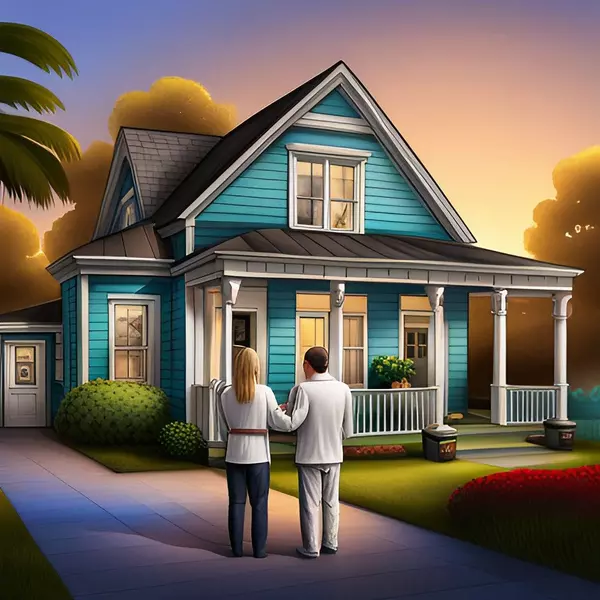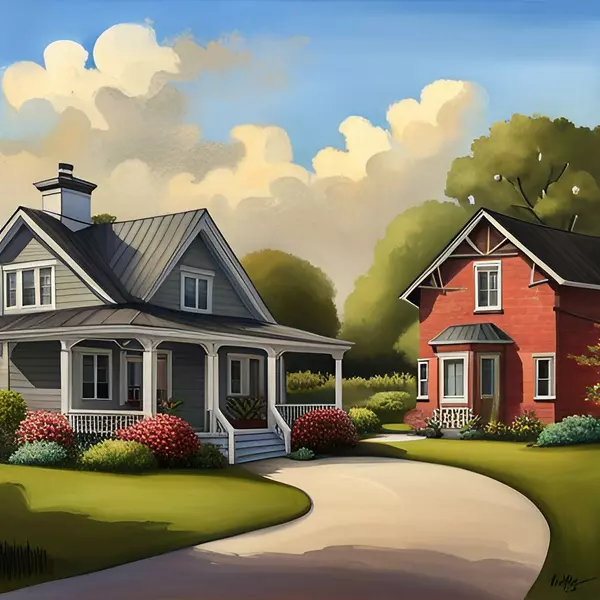2023 Home Buying Guide: What to Look for When Buying a Home This Year

Beginning your search for a new home can be an exciting yet scary experience. As the saying goes, "you don't know what you don't know". When it comes to buying houses, that couldn't be more true. If you're reading this, I'm sure you've already started to get an idea of what style of home you like, what features you want, and aesthetics that you enjoy. But what about the bones of a home? What do you look for, and how do you look for it? Knowing what to look for in different eras of homes can help you make a more informed decision and understand the potential of an older home.
1920s-1930s
Let's take a trip down memory lane to the roaring 20s-30s, an era of timeless charm and exquisite craftsmanship. These homes were the epitome of sophistication, with their elegant eave lines, impeccable brickwork, captivating window designs, and intricate details that are simply awe-inspiring. If you're on the hunt for a home from this period, keep an eye out for claw-foot tubs, ornate wood trim, original fireplaces with beautifully carved mantles, and secret doors and cabinets that will make your inner detective delighted. The possibilities are as endless as the intrigue of this bygone era!
With this era of homes also comes its own set of problems to look out for:
Outdated electrical - Electrical outlets and wiring from this era may not be up to modern safety standards. Knob and tube wiring was used during this period, and although it may still be functional, it should be updated to ensure safety. This type of wiring is not grounded, and is insulated with cloth which can pose a fire hazard. The home also may have an outdated electrical box with insufficient amperage to support modern appliances. Be sure to check as most homes need above 100 amps with today's electronics.
Insufficient insulation - Homes of this era often have poor insulation and can be drafty. Structures built before 1941 may not have any insulation in the walls, ceilings or floors, so don't forget to check for proper filling and sealing!
Plumbing issues - Plumbing from this time is more prone to leakage due to its narrower pipes. Many of these homes used galvanized steel pipes which corrode over time. The water pressure is also usually lower than that of a modern home, making it difficult to take advantage of the latest plumbing technologies.
Lead Paint and Asbestos - Although both are not harmful unless disturbed, lead paint and asbestos were commonly used during this time, so it is probably safe to assume they are in the home. Both are expensive to completely remove from a home, but they can be worked around. White tape around HVAC piping is a clear indication of asbestos, but these can be wrapped and sealed with foil tape to avoid disturbing. Lead paint is almost a guarantee, but is only dangerous if exposed to the dust or if ingested. Scraping the peeling paint off (NOT SANDING), and painting over removes most danger from lead paint.
Small, Outdated Kitchens and Bathrooms - Most kitchens and bathrooms from this era are small, functional spaces. Kitchens may lack enough counter space for modern appliances, or have limited storage options. Bathrooms may not have common amenities such as showers or tubs, instead opting for old-fashioned baths and sinks. Fortunately, these can be remodeled to accommodate a family's needs.
Insufficient Insulation - Windows and doors from this era are often less efficient at keeping the outside, well.. out. If you're living in a densely populated area, noise pollution can be an issue in these older homes. Consider investing in energy-efficient windows to reduce the noise from outside sources. The Insulation in the attic may be packed down, and require more to increase the R-value.
Inadequate Ventilation - It is common to see a bathroom without a ventilation fan, or one that goes straight to the attic. This can cause moisture issues over time, and promote mold growth, which is hazardous to your health. The same goes for kitchen ranges without proper ventilation; this needs to be addressed quickly to avoid any further damage from smoke buildup in the home.
If you're considering buying a home from this era, don't worry! These notes are here to inform you about the necessary steps and attention required. Investing in upgrades that enhance efficiency and comfort is a wise decision, as it can save you money in the long term. Don't forget to budget for regular upkeep to ensure your older home runs smoothly. Start your journey to homeownership with confidence!
1940s-1950s
The 1940s-1950s was a fascinating time in history, marked by the rise of modern conveniences in households. Keep an eye out for charming features like wood paneling, knotty pine cabinets, patterned tile floors, and authentic lighting fixtures from this era. Explore the unique style and design elements that defined this period of home décor.
Less Storage - The homes from this time period are usually smaller, with less storage space in the kitchen and bathrooms compared to other eras. You may find that closets are also significantly smaller than today's standards. This can be easily remedied through thoughtful storage solutions or adding a closet insert.
Dated Electrical - If you're looking at a home with original wiring, it's important to know whether the electrical has been updated. Although knob and tube wiring was no longer used in the 1950s, you may still find it in a 1940s home. Even without knob and tube, ground wiring did not become code until the 1970s. Appliances, computers, TVs, etc may need a circuit breaker between the outlet and system.
Lead Paint and Asbestos - Like homes built in the previous era, homes from the 1940s-1950s may contain lead paint and asbestos. If you're buying an older home, it's important to have it inspected by a professional for any potential hazards.
Outdated layouts - If you're in Ohio, MANY homes built in this era were cape cod style homes. These can be great starter homes, but are often missing some modern requirements, like a dining area, and more than one bathroom.
Foundation Issues - Any home can develop foundation issue due to poor maintenance, but over time a foundation can settle. If you are buying a home with a finished basement, it is important to know if the basement has been waterproofed, and if any bowing walls are being covered up.
Pest Infestations - Older homes are more susceptible to pests like termites due to being more easily accessed. If you find signs of infestations, it could mean a serious problem that needs to be addressed right away. It's important to have a professional inspect the home for any pest issues before making the purchase.
In conclusion, the homes from the 1940s and 1950s may throw a few curveballs your way, but hey, where's the fun in life without a little unpredictability? Embrace their unique charm and character, even if it means encountering some "interesting" electrical setups, hidden pests, or funky layouts. After all, what's an adventure without a few surprises? So, arm yourself with knowledge, bring in the right professionals for inspections, and get ready to start your story in a home that's filled with history and sprinkled with mystery. It's time to add some wit to your home sweet home!
1960s-1970s
Homes built in the 1960s-1970s era give us a glimpse of a transitional period in American architecture, as home designs began to evolve with the changing times. This period saw a shift from the conservative styles of the previous decades to more dynamic and modern designs. If you are looking at homes from this time, you'll notice more split-level and ranch-style houses, often built with a futuristic motif. However, as you admire the unique aesthetics of these homes, it's critical to be aware of potential issues common to properties from this period.
Design - One notable feature of 1960s-1970s homes is the concept of split-level designs. These designs utilize the available space in an intriguing way. However, it's crucial to remember that split-level homes usually count the lower level towards their finished square footage. This means that a portion of the total living space may be situated below grade, potentially leading to issues related to dampness and lack of natural light. This is also why split-level and bi-level homes are often lower priced than another style of home listed with the same square footage.
HVAC Systems - During the 1960s-1970s, HVAC systems' design and implementation were not as advanced as they are today. The piping was not always routed optimally, leading to uneven heat distribution throughout the house. As a result, certain areas of the home may be cooler than others, particularly during the colder months. This could lead to increased energy usage and higher utility bills as homeowners may need to use supplemental heating to make these colder rooms comfortable. When considering a home from this time period, it's important to thoroughly inspect the HVAC system and consider potential upgrade costs.
Insulation - A vital aspect to consider when looking at homes built in the 1960s-1970s is the insulation. During this era, the standards for insulation were not as high as they are today. This lack of insulation can lead to inefficient heat retention, resulting in a home that is more difficult to heat or cool effectively. Homes from this period may often feel drafty, have cold floors, or experience high heating and cooling costs. It's essential to remember that upgrading the insulation in these homes may be a necessary step to enhance comfort and energy efficiency. Always take into account the cost and potential impact of such improvements when considering properties from the 1960s-1970s.
Aluminum Wiring - Another unique characteristic of homes built during the 1960s-1970s is the widespread use of aluminum wiring, as opposed to the copper wiring more commonly used today. At the time, aluminum was chosen due to its cost-effectiveness and availability. However, it's important to note that aluminum wires can present a potential safety hazard. They tend to oxidize and corrode over time, which can lead to overheating, a higher risk of fire.
So there you have it, a snapshot into the unique world of homes built in the 60s and 70s. While they do bring their own set of quirks – like the charming avocado-green kitchen appliances, or the not-so-charming aluminum wiring – they also offer a nostalgically rich tableau that's a testament to the era's architectural evolution. Sure, they may require a bit of modern tinkering here and there, but with the right touch, these homes can blend the best of both worlds: retro appeal with contemporary comfort. Remember, owning a piece of history is priceless, even if it comes with an avocado-green bathroom suite!
1980s-1990s
By the 1980s-1990s, home design had shaken off its traditional roots and embraced a contemporary aesthetic with a touch of technological wizardry. From the outside, these homes flaunted symmetrical designs, large windows, and minimalist landscaping - the epitome of chic. Step inside, and you'd be greeted by bright interiors, open-concept floor plans, and the introduction of sleek materials like laminate countertops and vinyl flooring. It was a time when homes whispered, "Welcome to the future!"
Insulation - The 1980s was a time of increased energy efficiency in housing design, with double-pane windows becoming commonplace. Homeowners also had access to new gadgets such as microwaves and dishwashers, adding convenience to kitchen life. However, there are a few potential pitfalls to look out for when searching for homes from this era. The use of urea-formaldehyde foam insulation (UFFI) was common at the time, and if present in a home it can pose health and safety risks that need to be addressed.
Outdated Design Trends - These designs often compartmentalized the home into distinct, separate rooms, contrasting with the open-concept living spaces popular today. Such layouts, usually with a formal dining room, separate kitchen, and closed-off living areas, can feel restrictive and make the home seem smaller and darker. Oh, and let's not forget the unique charm of carpeted bathrooms in this era! As cozy as it may sound, it's a trend most of us are grateful stayed in the past. Tiptoeing across a plush carpet after a hot shower might have its appeal, but when functionality meets the reality of dampness and difficult cleanup, it quickly loses its allure! A bit of a design miss there, wouldn't you agree?
Aging HVAC Systems - It is possible for a home to have its original Furnace and A/C system, and while these may have been state-of-the-art in their time, they can become very costly to maintain and operate over the years. If you're looking for a home that is ready to move into, keeping an eye out for newer HVAC systems is important.
Original Roof - All roof styles have their own lifespan, but lets talk about the most used material in Ohio, which is asphalt. It is possible for a home built in the 1990s and even in the 1980s to have its original roof. Shingles then were rated for 20-30 years, and it is almost a guarantee the home is going to need a new roof, if it hasn't already received one. Some signs of an old roof are: missing, broken, curling or excessive sun-bleached shingles.
Decks and Balconies - Another noteworthy feature of homes, particularly those from the 1980s and onwards, is the outdoor living space. Decks and balconies were all the rage, offering homeowners a blissful escape to enjoy a morning coffee or host an evening soiree. Yet, like everything else, they're not without their share of issues. Over time, weather and use can cause wear and tear, leading to safety concerns. Cracks, loose boards, unstable railings - all signs of a deck or balcony crying out for love and attention.
In conclusion, homes built in the 1980s and 1990s offer a ton of charm, from their innovative designs to their appealing outdoor living spaces. But, it's a good idea to play detective while house hunting, keeping an eye out for signs of aging in things like the HVAC systems, roofing, and outdoor structures. With a keen eye and a bit of background knowledge, you might just score yourself a gem that needs just a little tender loving care to shine. Be prepared to invest in some updates, but know that the payoff could be well worth the effort!
2000s to Present Day
Now, let's fast-forward to the 21st century, where we see houses from the 2000s to the present day. This era, often referred to as the "New Millennium," heralded in a fresh perspective on home design and functionality. The emphasis shifted towards energy efficiency, open-plan layouts, and smart home technology. Homes built during these years often feature large, inviting spaces that flow seamlessly from one area to another - perfect for entertaining or family gatherings. Think gourmet kitchens, spa-like bathrooms, and dedicated home offices. But remember, newer does not always mean better. As always, keep your detective hat on, because even these modern beauties can have their own set of challenges! Prepare to enter the era of connectivity, eco-friendliness, and modern design.
Construction Quality - While these homes may be newer, and adhere to a stricter code, that doesn't necessarily make them better. Have you seen what a 2x4 looks like now vs in the early 1900s? Sure, the materials may be better quality and more efficient - but the home will still age. Watch out for signs of poor craftsmanship or inferior materials in any house you're considering.
Lowering Building Costs - Homes today are built to maximize square footage while also lowering expensive material costs. If you look at the eaves of a newer home (the part of the roof that sticks out past the walls of the house, they are almost non-existent. This can lead to more water related problems along the foundation. Although the foundations are built much better than they used to, make sure the grading of the house keeps water flowing away from the home. I'm sure you've heard of "builder grade" materials - they are lower cost and often not as durable. You'll see carpet that needs replaced after a couple of years, etching (leaks in glass) in lower quality vinyl windows, MDF cabinets. The home may even be missing some charm like window frames.
Aging Infrastructure - Be aware of the age of mechanical systems such as HVAC. If it is an early 2000s home, it may need the HVAC updated. The roof could be at the end of its life here as well.
To sum up, 21st century homes have their pros and cons. While they offer modern designs, eco-friendly features, and enhanced connectivity, some may prioritize cost-cutting, affecting craftsmanship and material quality. Despite stricter building codes, it's not uncommon for newer houses to show signs of aging or face water-related issues. Stay vigilant about mechanical systems, especially in older homes. But hey, who can resist the appeal of a smart home? Just take a careful look before diving into modern living!
Conclusion
And there you have it, my friends - a trip through time exploring the quirks and qualities of homes from different eras. Now, don't go getting cold feet on me! Just remember, every house - whether it's a charming 1920s bungalow or a slick 21st century smart home, has its own character and potential pitfalls. But, isn't that part of the adventure? After all, it wouldn't be called house 'hunting' if it wasn't a bit of an exciting chase. So, strap on those boots, put your detective's hat on, and happy home hunting!
Categories
Recent Posts











"Turning dreams into reality, one home at a time. Submit your information and lets start the journey to finding your perfect home or selling your Ohio property! "

